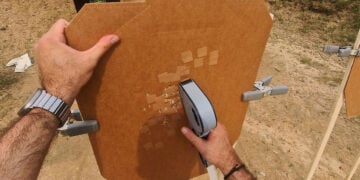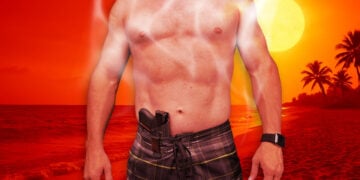There are many ways to carry your Concealed Carry handgun, once you obtain your Concealed Carry License or permit. The plethora of holster options include the traditional Outside-the-Waistband (OWB), Inside-the-Waistband (IWB), shoulder, ankle, pocket, small-of-the-back, appendix and belly band options, as well as several non-traditional methods like in a fanny pack, briefcase, day planner, and bra, etc. I really believe from my experiences over the years that there is NO general consensus on anything when it comes to concealed carry, id est the gun, holster, or method of carry. It is just a matter of personal preferences, but there are two things I would recommend you focus on. You should select a method that allows you to comfortably carry and adequately conceal your gun ALL the time. Of course, this can be a challenge depending on your body type and build, style of dress, lifestyle, location and temperature changes, preferences for where on your body you want to carry, etc. which can often dictate where you can and cannot place your handgun on your person… and some types of carry are definitely more comfortable and/or more concealable than others.
Click here to skip to the poll.
When shooters refer to where on their body they prefer to carry, they use references to the time as displayed on a clock, e.g. 3 o’clock, 4 o’clock, or 5 o’clock positions. So imagine yourself standing inside the center of a clock, with 12 o’clock being straight in front of you and 6 o’clock being directly behind you (at your 6 or back.) Your right hip would be 3 o’clock and your left hip would be at 9 o’clock. Pretty basic, but now you can visualize this like below if you are a new shooter. Most right-handed shooters (not all) carry their gun at the 3, 4, or 5 o’clock position.
Probably, you will need to have backup methods of carry based on your particular lifestyle and personal factors. After selecting the best carry method for yourself in your various situations and after a week or so of comfortably carrying a concealed firearm and getting accustomed to it, it will become a natural part of your daily routine, you will probably not even know you are carrying, and you will want to carry it with you forever.
You will probably need to experiment and use several different methods, depending upon your dress or attire at any one time, your type of daily work, sporting goods or recreational events that you participate in, and special activities or functions you attend, like weddings, church services, beach events, formal dress parties, jogging, etc. Also, the usual weather where you live influences your carry method, e.g. hot humid, shorts and t-shirt weather or cold, bundled-up parka or heavy coat weather. The majority of shooters choose to carry at the waist on their strong side, but not only do you have to choose where at the waist to carry, but whether your handgun will be inside or outside the waistband or even “off-body” carry.
So it is prudent to plan on a variety of carry methods based on these variables and other personal preferences. Whatever methods you select, you will need to learn and practice how to present your firearm quickly from those different methods of carry. Here are just 13 Carry Methods to consider.
Exploring these methods may lead you to upgrade your carry weapon. Cash for Arms can help, and offers practical solutions for gun sellers to sell easily, quickly, and for a great price.
See also: 11 Things to Consider When Choosing a Concealed Carry Holster
1. In an INSIDE-the-waistband (IWB) holster secured over your BELT
Behind the back, firing side hip, or cross draw on support side and covered by a shirt, vest, sweater or jacket. This is one of the best ways to carry a concealed handgun because it conceals most of the gun, keeps it close to your body and avoids all the problems associated with carrying a gun tucked inside your pants, especially with no holster. I believe this IWB method better conceals the gun, but can be less comfortable. A drawback to consider is that the width of the holster may require a slightly larger pant size and initially it takes some time to get used to the extra pressure and bulk of the holster wedged between your pants and body. You might want to buy the next larger size in your pants, but this may be sloppy depending on your build and some say the baggy look is not stylish. Your call.

In an INSIDE-the-waistband (IWB) holster CLIPPED to your BELT
Again, behind the back, firing side hip, or cross draw on support side and covered by a shirt, vest, sweater or jacket. IWB holsters are very popular and there are many options, ranging from appendix carry position to the small of the back.
This is a strong consideration, but some say not as good as a holster secured through your belt. Why? Because when you present your gun from a clip-on holster, it may come out with the gun and you could point at the bad guy with your holster still attached to your gun. This is dangerous and risky, but practice and a high quality IWB Clip helps.

See also: Criteria for Selecting Your IWB Holster
2. In a holster OUTSIDE-the-waistband (OWB) on a belt
Behind the back, firing side hip, or cross draw on support side and covered by a shirt, vest, sweater or jacket. This method is used by off-duty law enforcement and government agents in suits, for example, as well as many other shooters. This is one of the easiest methods of concealed carry to spot because the holster and gun on the outside of the belt create unnatural bulk in the area of the gun butt (the gun butt prints) and the barrel end of the holster often can be seen if the person carrying concealed has to lift his arms (like placing luggage in the overhead storage bin or getting something from a tall shelf) or when bending over. However, this is a very comfortable method of carry and I like it a lot, even when not wearing a suit. Choice of handgun model, width, and concealment garment are very important. There are many style and material choices, including injection-molded plastic or kydex, leather, nylon, hybrid leather and kydex, etc.
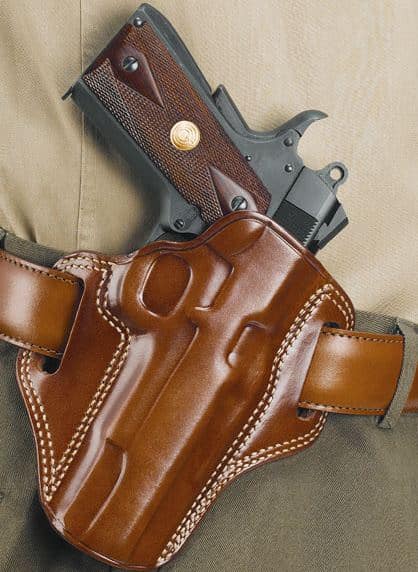
3. In a SHOULDER (underarm) holster with or without tabs securing to the belt and covered by a jacket (like in several TV & movie cop shows)
A shoulder holster can be a good choice if you do not want to wear your handgun on your waist, since they are easily concealable with a jacket and the gun is readily accessible. Many brands have adjustable straps, which can customize the fit to many different body types. With the right fitting holster, this can be a comfortable way to carry concealed, but requires wearing a jacket cut for the extra bulk of the holster or you are going to print the holster and gun. While it looks “cool,” it may require much attention to get the design to fit properly. Even weight distribution across the top of the shoulders is a key factor in comfort and usually requires an off-side retention strap, which prevents the off-side underarm strap from cutting into the shooter’s armpit and helps balance the weight of the gun and holster. It also tends to reveal the holster or gun often whenever the jacket opens from body movement or a breeze. A drawback is that when holstered the gun is pointing behind you at someone. Almost all shoulder holsters operate like crossdraw holsters, meaning that during the drawstroke, the gun at some point will be held horizontally and pointed straight away from the side of the shooter… a safety concern.

4. In an ANKLE holster covered by pants
This is really optimal for a backup gun as it is relatively SLOW to present a gun from an ankle holster as compared to the other methods of carry. It can be ideal for someone who is seated a lot, like professional drivers, or kneels a lot. Consider it may help in certain situations, since it is easier to draw from a kneeling position or if knocked to the ground. Similar materials are used for the ankle holsters as you would find in the inside-the-thigh holster and this may be a good method for women to use when wearing pants. However, it may be difficult to access when standing and it may affect your gait and walk, which could be a tipoff that you are carrying.
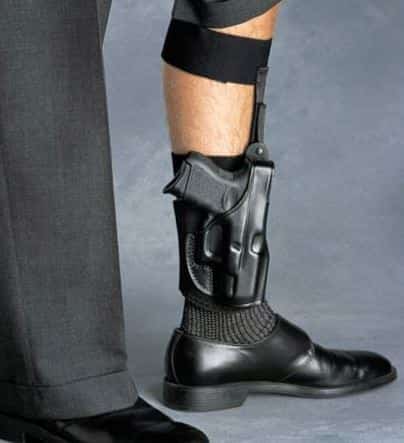
5. In a FANNY PACK
Recognize that if you carry this way, you probably are not hiding it from someone who is paying attention (perhaps criminals & cops), but hopefully that will be a small percentage and not affect you. This is called “Off Body Carry” (OBC) and this is the carry method many women carry their handguns, albeit in a purse or other ways. Briefcases, day planners, organizers, and over-the-shoulder pouches are also considered OBC and are used by men and women. It is important to use an OBC device with a lock and a reinforced strap to provide slightly more security if someone grabs it, tries to cut it off your shoulder or waist, or it is left someplace. The handgun is completely concealed and this method may be the optimal way to have a handgun close by. However, the downside is that OBC fanny packs, purses, planners, and handbags can be stolen, forgotten, or left behind, and drawing can be very slow, especially when they are locked. These methods may be ideal for hot days, picnics, the beach, etc. Make sure your gun fits completely inside the fanny pack and the Velcro or snap enclosures are secure. Get it specifically made for your handgun.
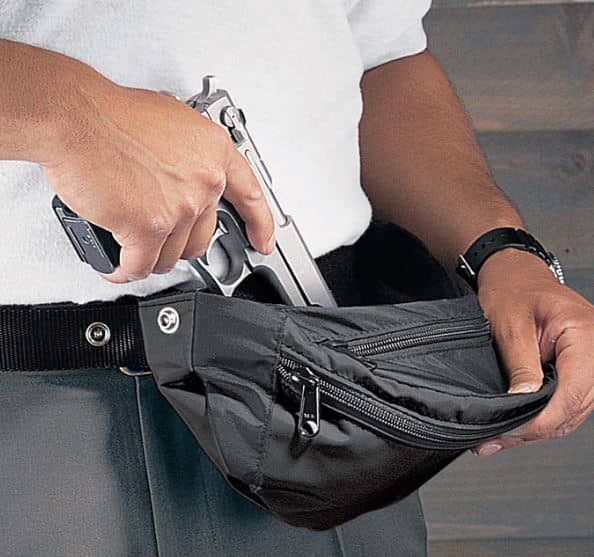
6. In a HANDBAG, DAY PLANNER, or BRIEFCASE
I believe that OBC in a handbag, purse or briefcase (or as above fanny pack) is NOT as good as carrying on your person, but will suffice in those situations where you cannot carry a gun on your body. The handbag, planner, or briefcase should have a designated holster built into it so the gun is secured. You do not want the gun moving inside the purse or briefcase for obvious safety reasons and if you need to draw it you want to know exactly where it is. If you are the type of person who forgets or misplaces your purse, planner, or briefcase, this is definitely not the method of carry for you. I admit this is not the method for me.

7. In an elastic (BELLY) BAND around the waist at the belt line or below
A belly band is simply a large elastic band that fits tightly around your hips and is secured by Velcro. It has multiple pockets to insert your handgun and spare magazine. They come in various sizes to accommodate different body shapes and tend to work well, especially for sub compact and compact small handguns. Carrying a full-size pistol might result in your friends commenting about how well you like your full-size 1911. If you participate in sports activities like running and working out, this option might work for you, since you have your gun on your body, it’s comfortable, and you have quick access. However, if you sweat a lot like me, most of them fit very tightly and do not wick the sweat away from your body and may actually contribute to more sweating. Rust on your gun is also a consideration, as is the dangerous direction the barrel is pointed when in the band. Belly bands, however, are flexible and do allow you to carry guns of various sizes, so you might want to consider them.
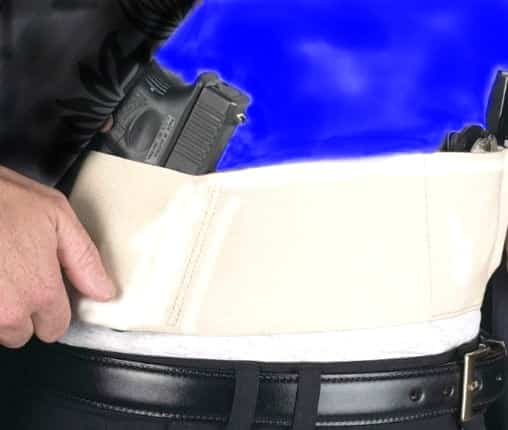
8. SMALL OF THE BACK (SOB)
With this method, the handgun is tucked into a holster in the middle back area where there is a natural inward indentation, generally around the 6 o’clock position and inside of your pants. While SOB carry can be comfortable while standing and very concealable, it usually is not the best option for those sitting or driving because of its awkwardness and cumbersome accessibility. If you spend a large amount of time sitting, having a large chunk of metal situated in the middle of your back can be very uncomfortable. Besides the obvious potential for spinal injury if you should fall on your gun, there are other disadvantages. Bending or stooping can cause the gun to print more readily. A weapon in the middle of your back is very difficult to protect in the event of a gun grab. There are strong opinions about SOB carry, with some loving it and others hating it, so again personal preferences and your personal desired features are the bottom line.
9. APPENDIX Carry
Aptly named, this type of carry means the handgun sits right where your appendix is, inside the waistband and
in the 2 o’clock position for those right-handed. It is a popular choice for small to medium-framed handguns inside the pants by your appendix. Recognize that because of the position of the holster in this location, the gun is pointed downward and directly at your femoral artery and your “junk,” so when drawing there is no room for errors. Some also say that it is uncomfortable when seated, but choosing an appropriately-designed holster will help. Others are quick to say that you can easily conceal a full-sized gun in your shorts and a t-shirt and that printing is non-existent. But body structure does influence this. Again, try it for yourself and your preferences.

10. In a THIGH holster
This is a very comfortable and good option for women to consider because a dress and skirt conceal a gun better than a pair of pants does for men. Stretch elastic and Velcro closures make the holster lightweight and comfortable to wear. Silicone grippers along the top and bottom edges usually keep the holster securely in place, so there is less need for an uncomfortable garter belt, but some have them. Some say the belt does keep it more secure from slipping, but others say that is its biggest disadvantage… slippage down the leg. Thigh holsters are suitable for sub compacts and mini guns, but usually are impractical for men or women wearing pants, as to access it you must drop your pants. Also, drawing and re-holstering are awkward but concealment is good.
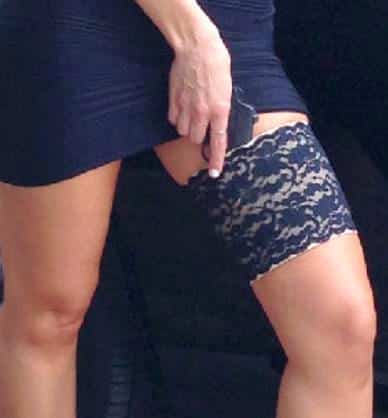
11. In a BRA holster under a dress, blouse or shirt
For large-breasted women this works well because the bust line creates the space below the bra for the gun to “hide.” I understand that it is not necessary to flash your bra to draw from the bra holster, since the handgun can be accessed by reaching under your shirt or blouse. Presentation is relatively fast to lift a blouse or tear away a button dress to access it. The element of surprise would be an advantage. To me, there is a safety risk with this bra holster, but I have not experienced this firsthand. The stored handgun points sideways in the holster, aimed directly toward your support arm. It seems to me that there is a great risk to press the trigger during access while the gun is still holstered, especially in a stressful encounter. I read a sad account of a Michigan lady who was a former military police officer in the Navy. This February, she accidentally shot herself in the eye and killed herself while adjusting her bra holster. Remember, keep your finger off the trigger until ready to shoot…. training and discipline.
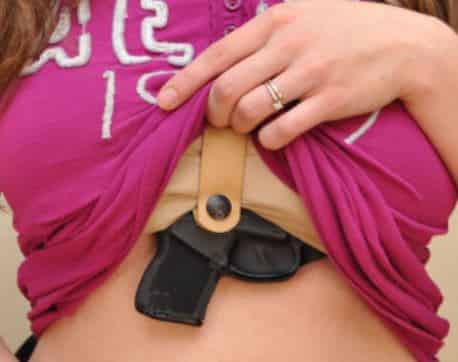
12. Tucked inside the pants with NO HOLSTER
Not that I agree with the terminology, but I have heard this referred to as “Mexican” carry. This is a very common method of carry and conceals the handgun good, but should only be considered by very experienced shooters— if at all. Most associate this method of carry with gangsters and thugs on the streets. This is a very dangerous method of carry and I do NOT recommend it. Non-holstered carry means the trigger is exposed and there is a greater chance for negligent discharge and injury or death. I always carry with a holster of some sort and never with the gun just tucked in my pants. Too risky!

Most who use this method are not aware of the problems and dangers associated with carrying a handgun tucked into the pants with NO holster. When they experience the problems the “hard” way after shooting themselves in delicate body areas, they will remember this embarrassment and the dangers. The gun can easily fall out while running or moving aggressively; the gun can slide down below the belt (and down the pant leg); you can have a bad draw and the gun may not be in the same place each time you attempt to present the weapon from concealment thus causing a slow draw; the trigger is not protected and clothing can interfere; your grip can be obstructed by items in your pockets; the frequent rubbing against body skin can cause the gun to rust; or body contact can accidentally press the magazine release or disengage the safety and decocker.
13. POCKET Carry in a side or back pocket of trousers or shorts inside a Holster:
Today we have a variety of smaller, compact and sub-compact handguns which lend themselves to inside the pocket carry. Below is my NAA Black Window .22 WMR in my pocket holster. The Old West gamblers, gunslingers, and sheriffs were some of the earlier ones to carry small guns like small revolvers and derringers in their pockets. I have read stories of some of these old-timers killing themselves with their own pocket gun. Of course, the gun’s weight, dimensions, smooth edges, caliber, your attire and typical body movements, and other factors help determine if this method is best for you. I am aware of some folks recently who have shot themselves while accessing, drawing, and/or presenting their gun from their pocket holster.. and most were injured in a delicate location, to say the least. So, you understand that this is not usually a most-preferred carry location/method. I caution pocket carriers that you do not want your gun loose in your pocket and not in a holster. Also, the type and quality of your pocket holster has much to do with your access and draw success, so research and shop for proven well-designed holsters for this purpose… and SAFELY PRACTICE your draw by dry-fire. There are many top -quality pocket holsters available, e.g. Galco, Safariland, DeSantis, NAA, Milt Sparks, Alessi, Rosen, etc. Make certain the extensions at the top and bottom edges of the pocket holster adequately catch on your clothing’s pocket as you clear the handgun, for a smooth, safe, and un-hindered access and draw. Your technique for drawing is key, so practice this so your hand is not obstructed by the clothing and in the proper position. Your drawing hand and fingers (with your trigger finger especially rigid and for me my thumb up high) should be straight as you enter the pocket, before you grip the gun in the pocket to avoid interference. PRACTICE SAFELY for your particular pocket gun! One tip I learned for safe re-holstering to the delicate location: Remove the empty holster from your pocket and then re-holster the gun into it in a safe environment. Then once safely holstered, return the gun and holster back to your pocket.
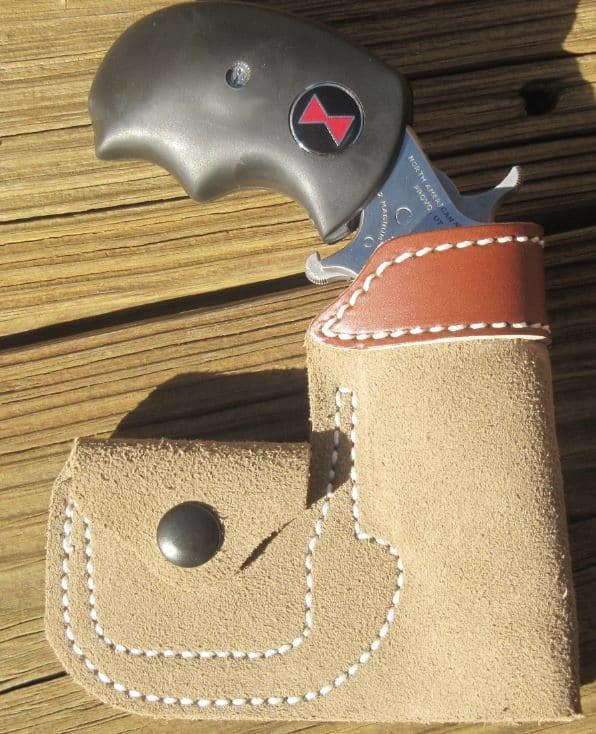
Carefully consider your personal lifestyle, your manner of dress, the weather where you live, your body style, and the various activities and events you are involved with, so you can select the optimum methods of carry for yourself. Try various methods to learn the best method for each of your particular guns and situations, so you will be comfortable carrying your concealed handgun…. and thus carry it always.
Continued success!
Photos by author and manufacturers.
* This personal opinion article is meant for general information & educational purposes only and the author strongly recommends that you seek counsel from an attorney for legal advice and your own personal certified weapons trainer for proper guidance about shooting & using YOUR firearms, self-defense and concealed carry. It should not be relied upon as accurate for all shooters & the author assumes no responsibility for anyone’s use of the information and shall not be liable for any improper or incorrect use of the information or any damages or injuries incurred whatsoever.
© 2023 Col Benjamin Findley. All Rights Reserved. This article may not be reprinted or reproduced in whole or in part by mechanical means, photocopying, electronic reproduction, scanning, or any other means without prior written permission. For copyright information, contact Col Ben Findley at [email protected].



